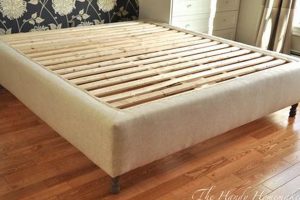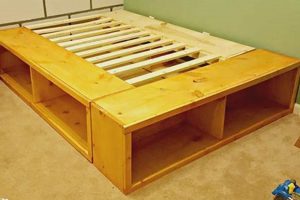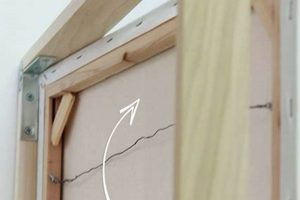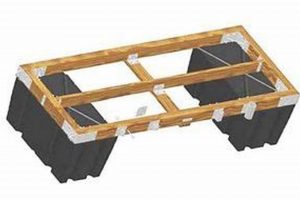A self-constructed support structure designed for suspending a seat intended for swinging motion on a porch or similar outdoor space. This structure typically involves constructing a frame from materials like wood or metal, capable of bearing the weight of the swing and its occupants. Common examples include A-frame constructions, rectangular frames attached to existing porch supports, or standalone structures built from scratch.
The construction of these support structures offers several advantages, including cost savings compared to purchasing pre-made units, customization options to fit specific porch dimensions and aesthetic preferences, and the satisfaction of creating a functional and decorative element. Historically, homemade swings and their supporting structures have been a feature of domestic landscapes, representing leisure and community. The act of constructing such a frame allows for tailoring the swing’s size, style, and material to perfectly complement the surrounding environment.
The following sections will detail the considerations involved in planning and executing the construction of a suitable and safe support. These will cover aspects such as material selection, structural design, construction techniques, and safety precautions, ensuring a long-lasting and enjoyable addition to any porch.
Construction Considerations
The following recommendations are intended to assist in the successful and safe construction of a supporting structure for a porch swing. Adherence to these guidelines can enhance the longevity and stability of the finished product.
Tip 1: Material Selection: Employ pressure-treated lumber or naturally rot-resistant wood species such as cedar or redwood for all structural components. This will mitigate the risk of decay due to exposure to the elements, ensuring long-term stability.
Tip 2: Structural Integrity: Ensure the frame is adequately braced to withstand both vertical and lateral forces. Utilize diagonal bracing or gusset plates at critical joints to enhance stability and prevent swaying. Consult structural engineering guidelines for appropriate load-bearing calculations.
Tip 3: Hardware Selection: Employ galvanized or stainless steel hardware to prevent corrosion. Use appropriately sized bolts, screws, and lag bolts suitable for outdoor use. Consider the weight capacity of all hardware to ensure it meets or exceeds the anticipated load.
Tip 4: Secure Anchoring: If attaching the frame to an existing porch structure, ensure the connection points are structurally sound and capable of supporting the weight. Employ appropriate anchoring methods, such as through-bolting or using heavy-duty lag screws, into solid wood or concrete.
Tip 5: Precise Measurements: Accurate measurements are crucial for ensuring a level and stable swing. Double-check all dimensions and angles before cutting and assembling the frame components.
Tip 6: Protective Coating: Apply a weather-resistant sealant or paint to all exposed wood surfaces. This will provide an additional layer of protection against moisture and UV damage, extending the lifespan of the structure.
Tip 7: Safety Inspection: Upon completion, thoroughly inspect all connections and structural elements. Test the swing frame with a gradually increasing load to ensure its stability and weight-bearing capacity before regular use.
Implementing these recommendations will contribute to the creation of a robust, safe, and aesthetically pleasing structure. Proper construction techniques and material selection are vital for ensuring the swing provides years of enjoyment.
The subsequent sections will discuss specific design options and provide step-by-step construction guidance.
1. Material Durability
Material durability is a paramount consideration in the context of self-constructed swing support frameworks. The selection of appropriate materials directly impacts the structure’s longevity, safety, and resistance to environmental degradation. Inferior materials compromise structural integrity and necessitate premature repairs or replacement.
- Resistance to Environmental Degradation
Wood, the most common material, is susceptible to moisture, insect infestation, and UV radiation. Pressure-treated lumber, naturally rot-resistant species like cedar, or the application of protective coatings mitigate these risks. Failure to address these factors results in warping, cracking, and ultimately, structural failure.
- Load-Bearing Capacity Retention
Materials selected must maintain their load-bearing capacity over time and under varying environmental conditions. Exposure to excessive moisture can weaken wood fibers, reducing their ability to support the weight of the swing and its occupants. Choosing materials with inherently high strength-to-weight ratios and employing appropriate reinforcement techniques are essential.
- Corrosion Resistance of Fasteners
The fasteners used to assemble the frame play a crucial role in its overall durability. Utilizing galvanized or stainless steel hardware prevents corrosion, which can weaken connections and compromise the structural integrity of the frame. Regular inspection and replacement of corroded fasteners are necessary maintenance procedures.
- Dimensional Stability Under Fluctuations
Materials should exhibit minimal expansion and contraction in response to temperature and humidity changes. Excessive dimensional instability leads to joint stress, warping, and eventual failure of the structure. Seasoned lumber, properly dried and acclimatized to the local climate, minimizes these issues.
The interplay of these facets underscores the critical role of material durability in the successful construction of a safe and long-lasting self-constructed swing support. Comprehensive assessment of material properties and environmental factors is essential for optimal performance and minimizes future maintenance.
2. Joint reinforcement
Joint reinforcement is a critical aspect of a self-constructed swing support frame. The integrity of these junctures directly affects the overall stability and load-bearing capacity of the structure. Insufficiently reinforced joints represent a primary point of potential failure, jeopardizing the safety of users. Examples of effective reinforcement strategies include the use of gusset plates, metal brackets, or interlocking joinery techniques such as mortise and tenon or dovetail joints. These methods distribute stress and prevent movement at the connection points. The application of appropriate adhesive compounds, rated for outdoor use and structural bonding, further enhances joint strength and resistance to environmental stressors. The absence of adequate reinforcement can lead to racking, deformation, and eventual collapse of the frame under load.
Practical application of joint reinforcement principles involves careful consideration of the forces acting on the frame. Swing supports are subjected to both vertical loads (the weight of the swing and occupants) and lateral forces (swinging motion, wind). Reinforcement strategies should address both types of stress. For instance, diagonal bracing between vertical posts and horizontal beams provides resistance to racking caused by lateral forces. Additionally, the selection of fasteners (bolts, screws, nails) should align with the intended load and material characteristics. Over-driving screws or using undersized bolts can weaken the wood fibers and compromise joint strength, effectively nullifying reinforcement efforts. Furthermore, proper pre-drilling can prevent splitting and ensure that fasteners achieve maximum holding power.
In summary, effective joint reinforcement is indispensable for safe and durable self-constructed swing supports. The selection and implementation of reinforcement techniques should be based on a thorough understanding of the structural loads, material properties, and environmental factors. Neglecting this aspect can undermine the entire project, leading to potential hazards and premature failure. Therefore, meticulous attention to joint reinforcement is paramount for realizing a robust and long-lasting swing support frame.
3. Weight distribution
Weight distribution constitutes a crucial engineering consideration in the design and construction of a self-constructed swing support frame. Uniform and controlled distribution of loads minimizes stress concentrations, enhancing structural integrity and ensuring user safety. Improper weight management can lead to premature failure, posing a significant risk.
- Load Balancing Across Support Members
The frame must distribute the weight of the swing and its occupants evenly across all load-bearing members. This requires careful consideration of the span lengths, material properties, and connection points. For example, a frame with unevenly spaced support posts will experience higher stress on the post bearing the greater share of the load. Corrective measures include employing larger dimension lumber for critical members, strategically placing reinforcement, and ensuring symmetrical frame design.
- Suspension Point Optimization
The points at which the swing is suspended from the frame significantly influence weight distribution. Suspension points should be located to minimize bending moments on the frame members. For instance, suspending the swing close to support posts reduces the bending moment on the crossbeam. Careful calculation of suspension angles and distances is essential for optimal weight distribution and reduced stress.
- Dynamic Load Accommodation
A swing support must accommodate dynamic loads resulting from swinging motion. These loads are not constant and can exceed the static weight of the swing and its occupants. The frame design should incorporate a safety factor to account for these dynamic forces. Employing a wider stance for the frame, using heavier gauge materials, and incorporating damping mechanisms can mitigate the effects of dynamic loading.
- Foundation and Ground Contact Considerations
The method by which the frame interacts with the ground or porch structure affects weight distribution. Uneven ground can create stress concentrations on the frame. Utilizing a level foundation and ensuring uniform contact with the supporting surface are essential. For free-standing frames, properly sized footings or concrete pads distribute the load over a larger area, preventing sinking or shifting.
These facets, viewed collectively, underscore the importance of meticulous attention to weight distribution when constructing a swing support. Correct implementation of these principles results in a safe, durable, and aesthetically pleasing structure. Conversely, neglect of these factors increases the risk of structural failure and potential injury, highlighting the necessity of sound engineering practices.
4. Anchor security
Anchor security, regarding self-constructed swing frames, is paramount for ensuring structural integrity and user safety. The integrity of the anchoring system directly correlates with the ability of the frame to withstand static and dynamic loads generated by swing usage. Failure of the anchoring mechanism can lead to catastrophic structural failure, resulting in potential injury or property damage.
- Load Transfer Mechanism
Anchors serve as the critical interface between the swing frame and the supporting structure, whether it be a porch, deck, or ground foundation. The chosen anchor type must effectively transfer the forces exerted on the frame to the supporting structure without deformation or failure. Examples include through-bolting to a solid structural member, using expansion anchors in concrete, or employing ground anchors for freestanding frames. Inadequate load transfer leads to stress concentration and potential anchor pull-out.
- Material Compatibility and Corrosion Resistance
The anchor material must be compatible with both the swing frame material and the supporting structure to prevent galvanic corrosion or other forms of material degradation. Employing galvanized or stainless-steel anchors is essential for outdoor applications. Using dissimilar metals in contact can accelerate corrosion, weakening the anchor’s holding power. Regular inspection and replacement of corroded anchors are necessary maintenance procedures.
- Anchor Type Selection Based on Substrate
The selection of the appropriate anchor type hinges on the characteristics of the supporting substrate. Anchors designed for concrete are unsuitable for wood, and vice versa. Using the wrong anchor can compromise its holding power and lead to premature failure. For example, using a standard wood screw in concrete provides minimal holding strength compared to a properly installed concrete anchor.
- Installation Technique and Torque Specifications
Proper anchor installation is crucial for achieving the rated holding capacity. Adherence to manufacturer torque specifications ensures that the anchor is properly set and engaged with the supporting structure. Over-torquing can damage the anchor or substrate, while under-torquing can result in insufficient holding power. Using a calibrated torque wrench and following installation guidelines is essential.
The aforementioned elements collectively underscore the criticality of anchor security in the successful construction of a safe and reliable swing frame. Neglecting these factors can undermine the structural integrity of the entire assembly. The correct selection, installation, and maintenance of anchors are thus vital for the longevity and safety of any self-constructed swing installation. Consideration of environmental factors, load requirements, and material properties will inform appropriate anchor strategies.
5. Dimensional accuracy
Dimensional accuracy represents a foundational element in the successful construction of any self-assembled structure, including a swing framework. In the context of a swing frame, precise measurements and adherence to design specifications directly influence the structural integrity, stability, and overall safety of the finished product. Inaccurate dimensions propagate errors throughout the construction process, leading to misalignment of components, compromised joint strength, and an increased risk of structural failure. For example, if the vertical supports are not precisely the same height, the swing will hang unevenly, placing undue stress on one side of the frame and potentially leading to its collapse under load.
The practical implications of dimensional inaccuracy extend beyond structural concerns. Misaligned components affect the aesthetic appeal of the frame, diminishing its visual integration with the surrounding environment. A crooked or asymmetrical frame detracts from the intended aesthetic. Furthermore, inaccurate measurements increase material waste, as components may need to be recut or discarded altogether. Consider a scenario where the crossbeam supporting the swing is cut too short. The entire piece of lumber is rendered unusable, requiring the purchase of additional materials and adding to the overall cost of the project. Conversely, a crossbeam cut too long requires additional trimming, consuming time and potentially compromising the structural integrity of the lumber if the trimming process is not performed precisely.
In summary, dimensional accuracy is not merely a matter of aesthetic preference but a critical factor dictating the safety and longevity of a self-constructed swing support. Precise measurements, careful cutting, and meticulous assembly are essential for achieving a structurally sound and visually appealing outcome. Neglecting dimensional accuracy introduces unnecessary risks, increases material waste, and ultimately compromises the intended function of the swing frame. Therefore, a thorough understanding and rigorous application of dimensional principles are indispensable for a successful building endeavor.
6. Weather resistance
Weather resistance is an indispensable attribute of any self-constructed swing support intended for outdoor placement. These structures are continuously subjected to a range of environmental stressors, including precipitation, solar radiation, temperature fluctuations, and humidity. The degree to which a frame resists these elements directly impacts its longevity, structural integrity, and overall safety. Inadequate weather resistance initiates a cascade of detrimental effects, commencing with material degradation and culminating in potential structural failure. For example, untreated lumber exposed to repeated wetting and drying cycles is susceptible to rot, warping, and insect infestation, compromising its ability to bear the intended load.
The selection of appropriate materials and the application of protective coatings are pivotal in achieving adequate weather resistance. Pressure-treated lumber, naturally rot-resistant species such as cedar or redwood, and the use of durable, weather-resistant finishes are all viable strategies. Specific examples include the application of marine-grade varnish, exterior-grade paints with UV inhibitors, and the use of galvanized or stainless-steel hardware to prevent corrosion. Furthermore, design considerations can enhance weather resistance. Proper drainage to prevent water accumulation, adequate ventilation to promote drying, and the incorporation of overhangs to shield the frame from direct precipitation are all beneficial design elements.
Ultimately, weather resistance is not merely an ancillary consideration, but a fundamental requirement for any self-constructed swing support. Proactive measures taken to mitigate the effects of environmental stressors will significantly extend the lifespan of the structure, reduce maintenance requirements, and ensure the safety and enjoyment of users. The initial investment in weather-resistant materials and construction techniques yields long-term benefits, both economically and practically. Failing to address weather resistance adequately results in a compromised structure, subject to premature deterioration and potential failure, thereby underscoring the importance of this factor in the context of outdoor swing support construction.
Frequently Asked Questions
The following addresses common inquiries regarding the construction, safety, and maintenance of self-constructed support frameworks.
Question 1: What is the minimum load-bearing capacity required for a safe support?
The minimum load-bearing capacity must exceed the combined weight of the swing itself, the anticipated maximum number of occupants, and a safety factor of at least 2. Building codes and structural engineering guidelines should be consulted to determine precise requirements based on local conditions and intended use.
Question 2: What are the recommended materials for constructing a durable frame?
Pressure-treated lumber, naturally rot-resistant wood species such as cedar or redwood, and steel are commonly employed. The selection depends on aesthetic preferences, budget considerations, and structural requirements. Each material possesses unique properties regarding strength, weight, and resistance to environmental degradation.
Question 3: How should the frame be anchored to ensure stability?
Anchoring methods vary depending on the supporting structure. Options include through-bolting to a solid structural member, using expansion anchors in concrete, or employing ground anchors for freestanding frames. The anchoring system must effectively transfer the forces exerted on the frame to the supporting structure without deformation or failure.
Question 4: What safety precautions are essential during the construction process?
Wearing appropriate personal protective equipment, such as safety glasses and gloves, is essential. Utilizing power tools safely and following manufacturer instructions are imperative. Ensuring a stable and level work surface minimizes the risk of accidents. Consulting with a qualified professional is recommended for complex structural designs.
Question 5: How often should the frame be inspected for potential issues?
Regular inspections are crucial for identifying potential problems early. A thorough inspection should be conducted at least twice per year, focusing on structural integrity, fastener corrosion, and signs of wood rot or insect infestation. Addressing identified issues promptly prevents further damage and ensures continued safety.
Question 6: What are the best methods for protecting the frame from weather damage?
Applying weather-resistant sealants, paints with UV inhibitors, or marine-grade varnishes protects the frame from moisture, solar radiation, and temperature fluctuations. Ensuring proper drainage and ventilation minimizes water accumulation. Regular reapplication of protective coatings is necessary to maintain weather resistance.
These answers address common concerns regarding self-constructed support structures. However, this information should not substitute for professional advice. Consultation with qualified structural engineers and experienced builders is advisable for complex or unconventional designs.
The next section will discuss common design variations and their suitability for different porch environments.
Concluding Remarks
The preceding discourse has explored critical aspects of constructing a self-supporting swing structure. Emphasis has been placed on material selection, structural integrity, anchoring techniques, dimensional precision, and weather resistance. These factors collectively determine the safety, longevity, and overall performance of the structure. The absence of meticulous attention to any of these areas can compromise the entire project, potentially leading to hazardous conditions.
The creation of such a structure demands diligence and a commitment to sound engineering principles. Further investigation into relevant building codes and consultation with qualified professionals are strongly advised before undertaking construction. Such due diligence ensures not only a lasting enhancement to the intended space but, more importantly, the safety and well-being of all users.







